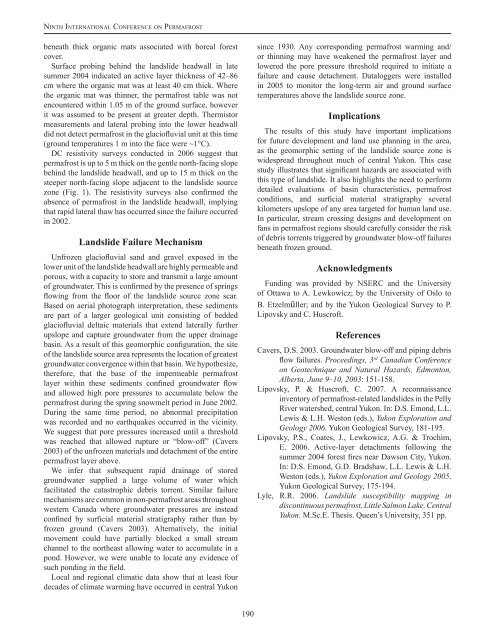Ninth International Conference on Permafrost ... - IARC Research
Ninth International Conference on Permafrost ... - IARC Research
Ninth International Conference on Permafrost ... - IARC Research
You also want an ePaper? Increase the reach of your titles
YUMPU automatically turns print PDFs into web optimized ePapers that Google loves.
Ni n t h In t e r n at i o n a l Co n f e r e n c e o n Pe r m a f r o s tbeneath thick organic mats associated with boreal forestcover.Surface probing behind the landslide headwall in latesummer 2004 indicated an active layer thickness of 42–86cm where the organic mat was at least 40 cm thick. Wherethe organic mat was thinner, the permafrost table was notencountered within 1.05 m of the ground surface, howeverit was assumed to be present at greater depth. Thermistormeasurements and lateral probing into the lower headwalldid not detect permafrost in the glaciofluvial unit at this time(ground temperatures 1 m into the face were ~1°C).DC resistivity surveys c<strong>on</strong>ducted in 2006 suggest thatpermafrost is up to 5 m thick <strong>on</strong> the gentle north-facing slopebehind the landslide headwall, and up to 15 m thick <strong>on</strong> thesteeper north-facing slope adjacent to the landslide sourcez<strong>on</strong>e (Fig. 1). The resistivity surveys also c<strong>on</strong>firmed theabsence of permafrost in the landslide headwall, implyingthat rapid lateral thaw has occurred since the failure occurredin 2002.Landslide Failure MechanismUnfrozen glaciofluvial sand and gravel exposed in thelower unit of the landslide headwall are highly permeable andporous, with a capacity to store and transmit a large amountof groundwater. This is c<strong>on</strong>firmed by the presence of springsflowing from the floor of the landslide source z<strong>on</strong>e scar.Based <strong>on</strong> aerial photograph interpretati<strong>on</strong>, these sedimentsare part of a larger geological unit c<strong>on</strong>sisting of beddedglaciofluvial deltaic materials that extend laterally furtherupslope and capture groundwater from the upper drainagebasin. As a result of this geomorphic c<strong>on</strong>figurati<strong>on</strong>, the siteof the landslide source area represents the locati<strong>on</strong> of greatestgroundwater c<strong>on</strong>vergence within that basin. We hypothesize,therefore, that the base of the impermeable permafrostlayer within these sediments c<strong>on</strong>fined groundwater flowand allowed high pore pressures to accumulate below thepermafrost during the spring snowmelt period in June 2002.During the same time period, no abnormal precipitati<strong>on</strong>was recorded and no earthquakes occurred in the vicinity.We suggest that pore pressures increased until a thresholdwas reached that allowed rupture or “blow-off” (Cavers2003) of the unfrozen materials and detachment of the entirepermafrost layer above.We infer that subsequent rapid drainage of storedgroundwater supplied a large volume of water whichfacilitated the catastrophic debris torrent. Similar failuremechanisms are comm<strong>on</strong> in n<strong>on</strong>-permafrost areas throughoutwestern Canada where groundwater pressures are insteadc<strong>on</strong>fined by surficial material stratigraphy rather than byfrozen ground (Cavers 2003). Alternatively, the initialmovement could have partially blocked a small streamchannel to the northeast allowing water to accumulate in ap<strong>on</strong>d. However, we were unable to locate any evidence ofsuch p<strong>on</strong>ding in the field.Local and regi<strong>on</strong>al climatic data show that at least fourdecades of climate warming have occurred in central Yuk<strong>on</strong>since 1930. Any corresp<strong>on</strong>ding permafrost warming and/or thinning may have weakened the permafrost layer andlowered the pore pressure threshold required to initiate afailure and cause detachment. Dataloggers were installedin 2005 to m<strong>on</strong>itor the l<strong>on</strong>g-term air and ground surfacetemperatures above the landslide source z<strong>on</strong>e.Implicati<strong>on</strong>sThe results of this study have important implicati<strong>on</strong>sfor future development and land use planning in the area,as the geomorphic setting of the landslide source z<strong>on</strong>e iswidespread throughout much of central Yuk<strong>on</strong>. This casestudy illustrates that significant hazards are associated withthis type of landslide. It also highlights the need to performdetailed evaluati<strong>on</strong>s of basin characteristics, permafrostc<strong>on</strong>diti<strong>on</strong>s, and surficial material stratigraphy severalkilometers upslope of any area targeted for human land use.In particular, stream crossing designs and development <strong>on</strong>fans in permafrost regi<strong>on</strong>s should carefully c<strong>on</strong>sider the riskof debris torrents triggered by groundwater blow-off failuresbeneath frozen ground.AcknowledgmentsFunding was provided by NSERC and the Universityof Ottawa to A. Lewkowicz; by the University of Oslo toB. Etzelmüller; and by the Yuk<strong>on</strong> Geological Survey to P.Lipovsky and C. Huscroft.ReferencesCavers, D.S. 2003. Groundwater blow-off and piping debrisflow failures. Proceedings, 3 rd Canadian <str<strong>on</strong>g>C<strong>on</strong>ference</str<strong>on</strong>g><strong>on</strong> Geotechnique and Natural Hazards, Edm<strong>on</strong>t<strong>on</strong>,Alberta, June 9–10, 2003: 151-158.Lipovsky, P. & Huscroft, C. 2007. A rec<strong>on</strong>naissanceinventory of permafrost-related landslides in the PellyRiver watershed, central Yuk<strong>on</strong>. In: D.S. Em<strong>on</strong>d, L.L.Lewis & L.H. West<strong>on</strong> (eds.), Yuk<strong>on</strong> Explorati<strong>on</strong> andGeology 2006. Yuk<strong>on</strong> Geological Survey, 181-195.Lipovsky, P.S., Coates, J., Lewkowicz, A.G. & Trochim,E. 2006. Active-layer detachments following thesummer 2004 forest fires near Daws<strong>on</strong> City, Yuk<strong>on</strong>.In: D.S. Em<strong>on</strong>d, G.D. Bradshaw, L.L. Lewis & L.H.West<strong>on</strong> (eds.), Yuk<strong>on</strong> Explorati<strong>on</strong> and Geology 2005.Yuk<strong>on</strong> Geological Survey, 175-194.Lyle, R.R. 2006. Landslide susceptibility mapping indisc<strong>on</strong>tinuous permafrost, Little Salm<strong>on</strong> Lake, CentralYuk<strong>on</strong>. M.Sc.E. Thesis. Queen’s University, 351 pp.190
















